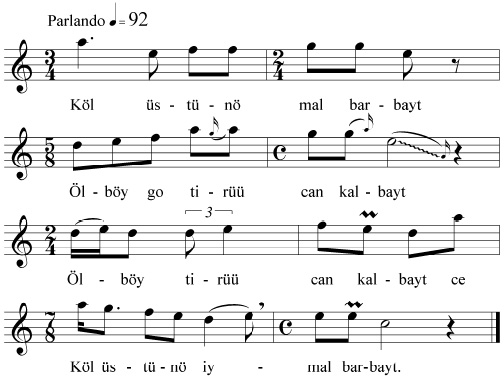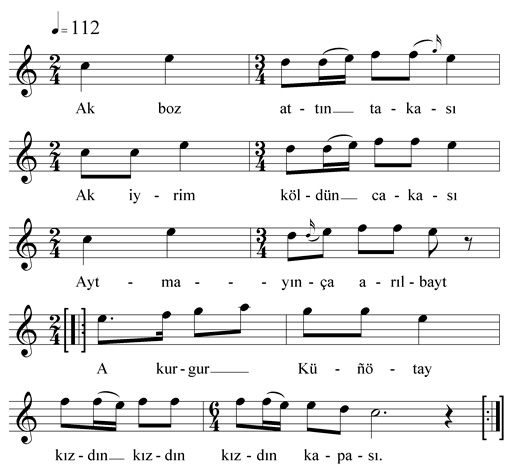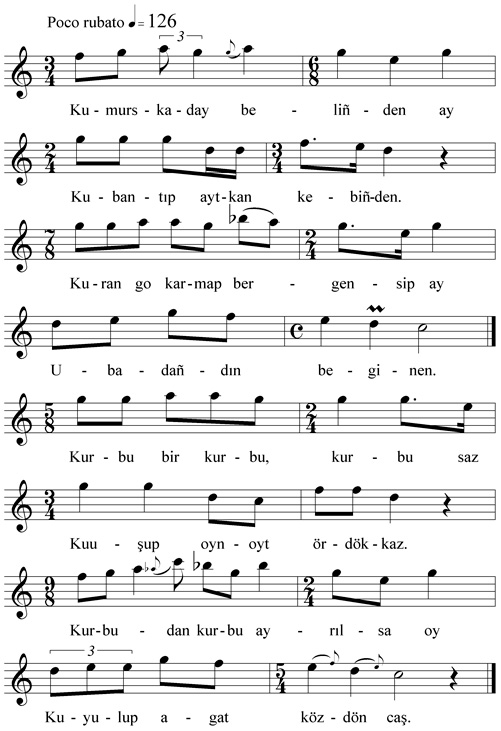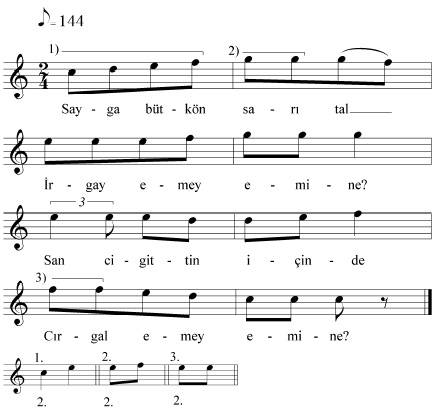- 1. Twin-bar tunes (ex.1-11, №1-58)
- Twin-bar tunes based on the g,-c bichord
- Twin-bar tunes based on rotating motifs
- Twin-bar tunes with descending/hill-shaped lines
- Motifs with a downward leap at the end of the line
- Motivic processes
- 2. Tunes moving on Ionian scales (ex.12-24, №59-164))
- Laments and their relatives
- Two-lined tunes of Major character with higher main cadences and their four-lined relatives
- Four-lined tunes of Major character
- 3. Aeolian tunes (ex.25-36, №165-238)
- Laments and related tunes
- Aeolian tunes with higher main cadence
- Four-lined tunes of Minor character
- Valley-shaped, ascending or undulating first line
- 4. Caramazan religious tunes (ex.37-41, №239-326)
- 5. Tunes of domed structure (ex.42-43, №327-332)
2.3. Four-lined tunes of Major character (ex.21-24, №133-164)
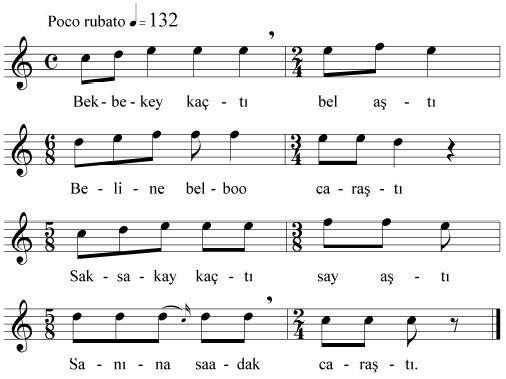


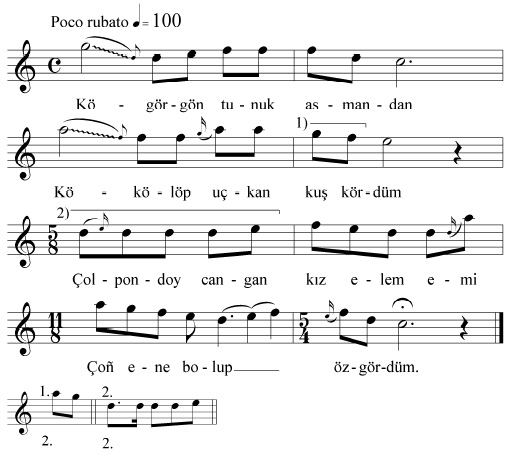


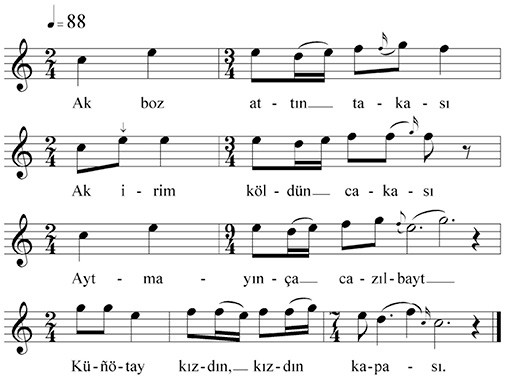


The following melodies of Major character have more distinct four lines, yet e.g. those of AB|AC form have undeniable ties with the two-part forms. Since unlike the AB|CB tunes, those of AB|AC form remain open at the end of the second line, they can be ranged with the four-lined tunes.
2.3.1. Tunes with 5(4)x cadences (ex.21a, №133-136). Five tunes belong here, several of them with the AB|AC form. Lines three usually end on the 4th, b3rd or 5th degree; №133 is unique as it can’t decide whether to choose B or D for its closure.
2.3.2. Tunes with b3/4(5)5 cadences (ex.21b, №137-138). Their first line typically closes deeper than the second, yet they do not produce the impression of a domed structure. They remind one more closely of a group of the Karachay jır tunes with similar cadences (Sipos–Tavkul 2012).
2.3.3. Tunes with 5(5)x cadences (ex.21c, №139-147). The first and second lines of several tunes in this group are similar. Their form can be schematized as AAvBC. In several cases, the cadential 5th degree is modified to the 7th or 6th degree (№142, 140, 146). The decisive note or note range of the first line determining the tunes is the 5th degree or the 5th-8th interval. The tunes with 5(5)5, 5(5)4, 5(5)b3 and 5(b3)b3 cadences and usually of AAAB, ABAvB, AABB or ABBB form display kinship with two-lined tunes with (5) cadence. №142 with 7/5(7)b3 cadences is put here on account of the similarity to ex.21c in the overall melody outline, to illustrate that despite different cadences melodies may be related to one another.
a)

b)

2.3.4. Tune variants with 6(6)6 and 5(5)5 cadences (ex.22a-b, №148). There are melodies that have variants with 6(6)6 and others with 5(5)5 cadences. This also confirms that in some groups of Kyrgyz folk music degree 6 can replace the 5th degree. In ex.22 we get an example of the occasional exchangeability of the 5th and 7th degrees.
a)

2.3.5. Tunes with 7/8(4/5)x cadences (ex.23, №149-155). The first line of tunes in this group usually ends high, on the 7th-8th degree, the main cadence usually being (4), and the third line moving generally higher. The AB|AC form also occurs. The starting lines usually ascend or sometimes trace a hill. At the end of the first line there is often a small rise.
2.3.6. Wide-ranged four-lined tunes with high main cadence (ex.24, №156-161). The fourth group of four-lined tunes are characterized by relatively wide tonal ranges and the 7th or 8th degree as the main cadence. Most tunes belonging here have short isometric (+|&@) lines. Although the wide range and isometry seemingly differentiate them from the rest of the Kyrgyz folksongs, they constitute an authentic group with genres such as Caramazan, Şırıldañ etc.
2.3.7. Tunes with an extraordinarily wide (b3-10) range (№162-164). These few tunes with extremely wide ranges are on the “periphery” of traditional Kyrgyz folk music.
There are a few four-lined tunes of domed or repetitive (ABCA) structure of Major character , which are discussed together with the rest of the domed tunes.
1 ex.21a, Bekbekey (watchman’s cry), Asan kızı Uulbübü (1938, Kırk-Kazık), Aydarbek, Ogombayev (Beştaş), 2004; ex.21b, Mother’s song, İrmanaliyeva Apar (1934), Sarıkpay, Üç-Emçek, 2004; ex.21c, Letter song, Ömürova Malike (1918, Karl Marks), Sayak, Barskoon, 2002
2 ex.22a, Sad song of Küñötay, Sagındıkov Koyçubay (1937), Çetigen, Köpüröbazar, 2004; ex.22b, Folksong, Turdumambetov Osmon (1938), Çerik-Sazan, Aça-Kayıñdı, 2002
3 ex.23, Folksong, Sagalı Taştanbekov (1926, Koşoy-Korgon), Çerik-Çeçey, At-Başı, 2002
4 ex.24, Song of brave riders (Şırıldan), Sagınbayev Keñeş (1942), Kezen Sarı, Taldı-Bulak, 2004

